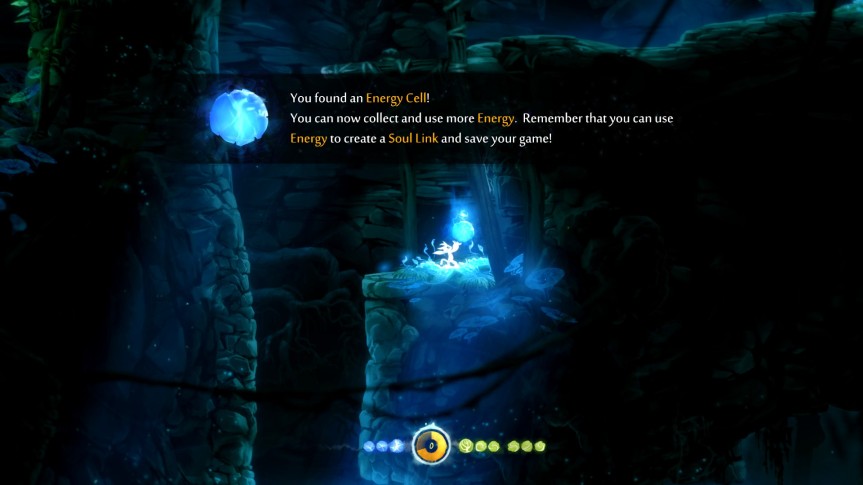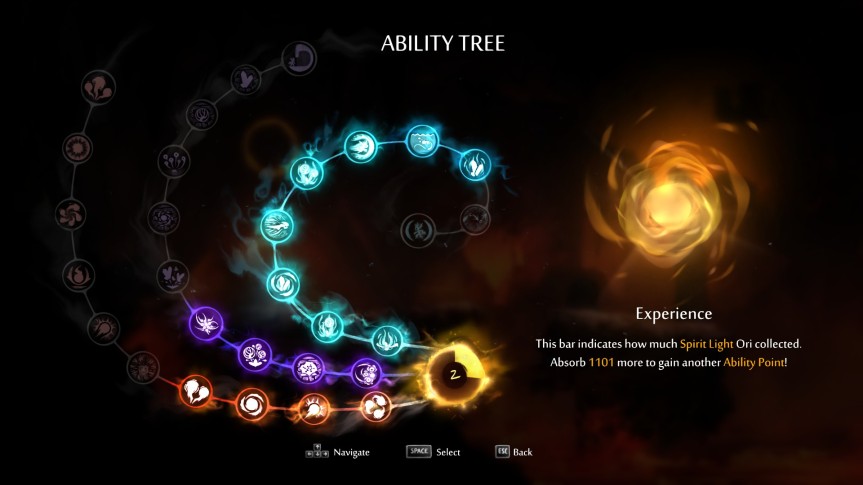Ori and the Blind Forest had been sat in my backlog for almost a year. I took an interest in the game way before then due to the stunning visuals originally catching my eye but I’ve always found myself waiting for the price to drop. However, when the sales came around, there always seemed to be a different game at the top of my priority list. Eventually I bought it for 50% off and I can vouch that it was absolutely worth the £7.49 I paid. I’d been putting off playing it for way too long so decided to finally take the plunge last month. I’m so glad I did and my only regret is that I didn’t play it sooner.
This game has been one of the most beautiful games I’ve ever had the pleasure of experiencing. The game itself as a whole is such a masterpiece and my adoration grew the more I played. The artwork, animation, sound design and music were all flawless so when pieced together, an incredible world came to life.

The level design was excellent. Each area had its own atmosphere and mechanics which provided a varied experience throughout including timed levels, anti-gravity zones and challenging gliding sections. To begin with, the areas were what you would expect from any puzzle platformer which eases you into the gameplay. As the game progresses, you unlock more abilities, allowing Ori to be more adventurous and better equipped on his journey. This resulted in being able to revist places later on that you couldn’t get to beforehand as well as using these skills to progress to the new areas.

The adventure progression flowed well and it was quite apparent where you should be going to proceed with the story. That being said, there was plenty of other places to explore and I can only recall two instances where I was completely unaware of what I needed to do to move on. After a little trial and error, I managed to figure it out and I felt rewarded with a sense of achievement.
I’ll be honest, the game certainly came with challenges. I’m not normally a fan of difficult games as I lack patience, so I opted to go with Normal Mode, not too easy but not out of my depth. I often feel like I need to challenge myself a little more as difficulty is one of the main reasons I’ve let games pass me by previously. Besides, playing on easy all the time can get boring.

One of my favourite features included in Ori and the Blind Forest was the way you can create temporary save points (Soul Links). These save points were incredibly helpful and it took the pressure off completing some tedious sections in one sitting. Struggling with a particular section? No fear! Just save before you make that difficult jump… If you die, you’ll respawn at that save point you made a few seconds earlier. Neat, right? I probably would’ve gotten too frustrated with this game to finish it without this save function.
Obviously there are some restrictions with saving. Firstly, you cannot save while stood too close to an enemy (fair enough). It costs half an energy cell to create a save point which can then be used multiple times after placement. Once a new temporary save point is created, the previous save point will be removed and all progress will continue from the new save point. Energy is gained by either destroying the blue plants / crystals found scattered throughout the levels or refreshing at a permanent save point. The Energy meter can also be expanded by finding orbs. There are also orbs for extra health as well which can be found in various places on the map.

Creating temporary save points (or using the permanent save points) also grants access to the ability tree. Here you can spend Ability Points which are earned by gathering Spirit Light from defeating enemies. Abilities are split into three separate branches and require points to unlock various traits. Each branch has to be unlocked from the bottom and abilities cannot be skipped. The paths are split into the categories of Combat, Utility and Efficiency.

Collectables and achievements are also included for those people who like to do more than follow the story. There are some particularly challenging achievements such as ‘Finish the game in under 3 hours’ and ‘Complete the game on One Life difficulty’. I was up for trying to get 100% completion, but after seeing these achievements, I decided to pass…

Overall, Ori and the Blind Forest is a game I would highly recommend to any gamer. In my opinion, all the aspects of the game were exceptional and there’s nothing I could particularly point out as being negative. My play through took around 15 hours which I believe was a respectable length for a game of this nature. I could’ve spent more time going after the collectables for a few more hours, but I felt satisfied after finishing the story.
Have you played Ori and the Blind Forest, or is it still sat in your backlog? Let me know your thoughts!

Great review! I just got around to playing this game last year and loved it. It had me in tears within 10 minutes of the opening scene, haha.
LikeLiked by 1 person
Thanks! It got me too, I wasn’t expecting it to be so emotional.
LikeLiked by 1 person